#Rainy Season in the Tropics
Text


Rainy Season in the Tropics by Frederic Edwin Church.
#Frederic Edwin Church#frederic church#Rainy Season in the Tropics#paint#painter#oil painting#painting#american#american art#alternative#aesthetic#dark academia#dark academic aesthetic#dark aesthetic#aestheitcs#dark#art#light acadamia aesthetic#light academia#natural#nature#naturist#naturism
4K notes
·
View notes
Text
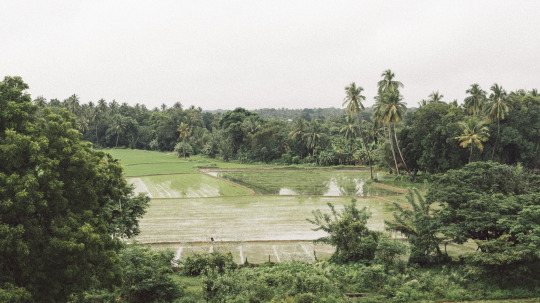
16.12.2023 | Rice fields in Polonnaruwa, Sri Lanka
#Sri lanka#travel#nature#polonnaruwa#rice field#green#all green#palm trees#tropical vibes#landscape#rainy season#rainy
4 notes
·
View notes
Note
you know what's pretty? fresh snow. you know what's even prettier? you <3
UR MAKING ME BLUSH ?!?!?!?!?!?!?!?

#ive nvr actually seen snow in person#its cuz the Phil is a tropical country#so we only get two seasons lol#the rainy season n the dry season#tfshouldianswer
3 notes
·
View notes
Text

Beach ready.
#my art#self portrait#i'm so bad at hot weather. i die at +21ºC#yesterday we got to 31ºC TT#please remember I live on a tropical country without seasons#fuck this ho weather i want to be hoooooome#i miss my 18ºC and my unpredictable rainy days
1 note
·
View note
Text
Near the ITCZ
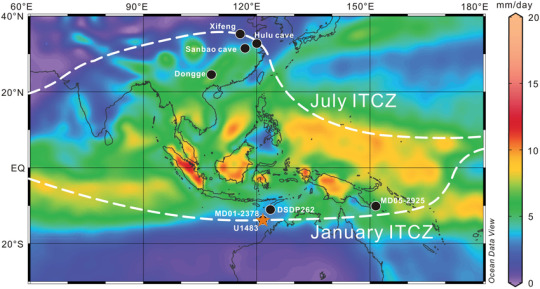
* This blog post was originally written on deviantArt in 2008, but was transferred to tumblr in 2023— and the picture above was added then. The picture is from a journal from The Journal of Geophysical Research Atmospheres, which was written in July 2020 and properly cited below:
Zhang, Peng & Xu, Jian & Holbourn, Ann & Kuhnt, Wolfgang & Beil, Sebastian & Li, Tiegang & Xiong, Zhifang & Dang, Haowen & Yan, Hong & Pei, Renjie & Ran, Yazhou & Wu, Hanning. (2020). Indo‐Pacific Hydroclimate in Response to Changes of the Intertropical Convergence Zone: Discrepancy on Precession and Obliquity Bands Over the Last 410 kyr. Journal of Geophysical Research Atmospheres. 10.1029/2019JD032125.
Whoohooo!
It's been a while, and as you know, I've started a new chapter of my life near the Intertropical Convergence Zone.
For those of you who don't know what that is, LOOK IT UP. You'll learn something new — here, as defined by the National Oceanic and Atmospheric Administration.
ANYWAY. to SUM IT UP.
It means i am experiencing some heavy downpour at the moment.
[wow. did that sound like something directly from a weather forcast of what?]
ANYHOW… though you might see it as unfortunate and SUCKS-TO-BE-YOU-THAT'S-WHAT-YOU-GET-FOR-LEAVING-THE-CALI-SUN…
I am honestly… happy.. to be experiencing this right now.
Why? Several reasons.
I have FORGOTTEN how GREAT it feels to feel the cold breeze brought on by the heavy rain come into the closed screen doors and window cracks.
It's been SOOOOOOOOOOOO LOOOOOOOOONG that I FORGOT that one's daily experience with the rain include hearing those bullets hit the roof continuously for hours and hours on end as if your house was being hit by a gazillion meteors.
I suddenly remember how much having the trees swaying the way it is in the CNN news when there's a hurricane is not really scary.. since you see it everyday.. just by looking outside the window. It's really does make me wonder why I would get a bit worried seeing those when I was still up there.. especially since I did grow up HERE >_>
I've forgotten how fascinating it is to look at the rain downpouring in a diagonal, sometimes curvy and swaying direction.. depending on the wind. It's really nice, especially at night when you look at the rain falling by the street lights.
Even though they gave me nightmares and a bunch of scary moments when I was a little child, I never would have thought I'd miss the sharp lightning that lit up the sky and it's accompanying thunder that shake the earth..almost a little too literally…
Reason #6? The most logical reason. It is waaaay better than the usual humidity. ^_^ soooo much better.
I missed feeling so… NATURAL about the entirety of the rainy season. It is a wonderful feeling. You feel like not doing anything else but sleep all daaaaaaaaaaaay.
..anyhow. it's the first time i've lived IN the city. and.. i think i'm getting used to it.
Typical Asia, i'm still working on getting used to the streets and roads.. but..i'll live.
what i can't wait to do is to go home to the province though.
anyhow.
i'm actually sleeping NORMALLY. for once. ^_^
it seems all along, i've been sleeping in the -8:00GMT time zone. hahaha
anyhow, i'll bring you guys some updates on my rants soon.
since i know this IS a PRETTY LONG rant..hahaha
c ya!
#life#life update#tropical weather#monsoon season#rainy season#Philippines#Asia#Southeast Asia#southeastasia#blogging#deviantart
0 notes
Text
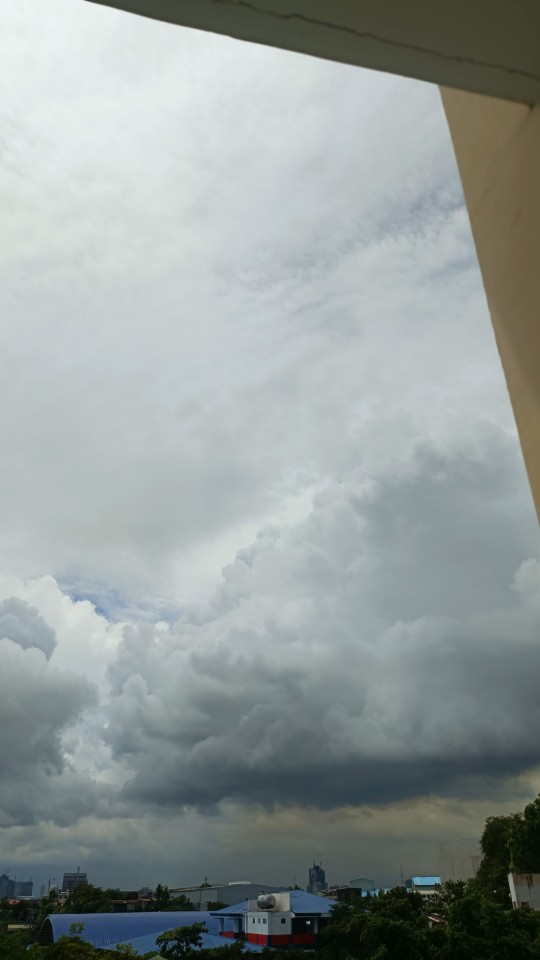
Bed weather
0 notes
Video
1 note
·
View note
Text
something about kagepro and yorushika songs that make me feel better about. just being
#thought.s#summer condensed into music..#i Will romanticize summer <- girl in tropical country experiencing rainy season
1 note
·
View note
Text
Pray tell, what must it be like living somewhere without constant mold in your lungs
#Christ I’ve been coughing my lungs up#I mean.#jesus#it’s just one of those things when you live on a rainy island#the university library is the only 24/7 place around but I can’t exactly sleep there#the damp is so bad this autumn for some reason#I don’t have the money to run a dehumidifier- who does!#I’ve been so busy I just kinda forgot about everything else#I can’t close my windows they’re broken so more rain gets in#I can’t turn on my heating#basically my living situation is actively damaging my health lol#jogging in place to stay warm at night before bed#got my hot water bottle though#christ I do miss living in the warm tropical sun when the days get shorter#I miss the sun and heat and being able to avoid seasonal depression sometimes!
0 notes
Text
i love my country

#shitpost#tropicalcountry#tropics#its the rainy season but its still so hot aaaa#the water in my water bottles keep evaporating
0 notes
Text
Earth 101: A Manual for the Visiting Cybertronian
Chapter Two : Earth Weather
Earth, with its vast biomes and diverse terrains, has a variety of weather patterns that can change drastically from day to day, and have particular seasons with which they are often divided.
This has also been the cause of …particular issues for the newcomer Cybertronian, as the climate can have adverse effects on our biomechanics.
As a gentle reminder, please be sure to thank your medic when leaving the med bay after repairs.A bottle or two of high-grade Energon also goes a long way.
Divided into the Northern and Southern hemispheres, Earth cycles through 4 seasons, each with their own type of weather.
The four seasons by which the planet goes through, as labeled as:
Spring : Temperate to warm weather, usually brings the thawing of winter and replenishing of flora and fauna alike.
Summer: The warmest of the seasons, the planting of crops and their growth occurs here, as well as many an activity in the sun
Fall or Autumn: Harvest season, known to be the beginning of a cooling in the weather and when most flora experience a change in color to prepare for the next season.
Winter: The coldest of the seasons, this season is also known as the ‘holiday season’ due to many Earth holidays occurring during the jours, or rather, Terran months it overlaps.
These seasons last roughly 3 months each, but due to changes in the Earth’s ozone layer in a phenomenon known as ‘global warming’, which has caused quite severe changes to the climate of Earth in some places.
Primus help them, we can only hope this does not continue with our presence here.
The Northern hemisphere is known to host generally colder climates, whilst the Southern hemisphere hosts warmer climates.
The planet’s equator is the centralized area of its warmest zone.
This said, interestingly enough, when it is summer in one hemisphere, it is often winter in the other, in a rather fascinating exchange!
They oppose each other, meaning that through the 3 months it is the opposite season in the other region.
The equator tends to average around the same weather all of the orbital cycle, known as a year, around the
Truly intriguing, the various weather patterns of Earth.
Earth is known to have various forms of weather, ranging from sunny days, cloudy, foggy, rainy or even snow.
That said, Earth weather can also be quite dangerous.
Storms such as hurricanes, tsunamis, tropical storms, and blizzards can devastate entire sections of Earth, and even wipe entire cities off the map.
We have witnessed some of these devastating incidents.
We only hope that humans can find peace after these tragedies.
With each type of weather of course, come certain rules and warnings about potential hazards that could occur.
For example, not even the greatest of the Autobots is immune to the icy roads of the northernmost parts of the world, as our beloved Prime informed us after he spun out due to a particularly vicious patch of black ice amidst a snow storm.
Luckily no harm was done, as he crashed into the snow on the roadside. All that was harmed was perhaps his dignity when he informed us about the incident in a kind reminder to not repeat his actions, so as to avoid harm to ourselves and to others on the road.
Ever so watchful is he.
The same cannot be said for …others within our ranks however.
Incidents with wild weather reported for documentation within this field guide are as follows:
A scientist studying the weather patterns of Earth amidst a particularly wild storm learned what the function of the aptly named lightning rod was. By becoming one involuntarily. Thankfully, said patient now seeks shelter when such storms come to pass.
One of our scouts learned the hard way that driving through fog can be a disorienting and frightening experience. It is not for the faint of Spark. Proceed with caution
Hailstorms. Spheres of ice sometimes the size of Scraplets that falls from the skies. It is as terrifying as it sounds.
One too many Autobot and Con alike have tried to become what is known on Earth as 'storm chasers'. Medical Officer Ratchet implores that the next to attempt such, will only learn from being swirled within a tornado and that the damage from such an event is very tedious to repair.
Please do not attempt to drive through flooded areas after heavy rains. Your engine will become full of water and proceed to stall. It is not worth splashing each other to have this happen.
High winds can push even the largest of us off the road. And we do mean this literally.
We advise parking indoors when choosing to remain in vehicle mode or keeping your heating on when in cold weather. Your vehicle mode can in fact be encased in ice entirely if not careful. It is as annoying and freezing as it sounds.
For those who are flight inclined, be they Decepticon, Autobot or neutral, be aware of snow, rain, lightning, hail, and more, as they can blind the pilot if particularly severe. Even the well known Starscream has been known to crash land due to hail and sleet causing less than optimal flying conditions.
Heatwaves [No we do not mean the Sigma-17 leader, Heatwave] can be cause for our biomechs to overheat and falter, requiring significant cooling, as there have in fact been cases of engines catching on fire or outright shutting down from the intense heat.
Beware of blizzards, as we do not wish anyone to freeze within the piles of snow known to loosen in this.
Earthquakes can cause catastrophic chains of events to occur. Please be aware that aftershocks may occur afterwards.
The rescue team known as Sigma-17 has told us of a good many weather incidents like those mentioned within this chapter. Their testimony was vital for this chapter, and we thank them for their duty in rescue operations of all manner.
Please be sure to contact an official, medic or rescue service in the event of an emergency or accident, no matter the severity.
This concludes our initial overview of Earth Weather and Climates.
Direct appropriate queries to the proper channels for more information.
#earth 101 : a manual for the visiting cybertronian#transformers#transformers prime#tfp#tf prime#maccadam#maccadams#tf bayverse#tf rid 2015#tf rid15#tf rescue bots#rescue bots#transformers rescue bots#rescue bots academy#tf rescue bots academy#nova writings#nova notes
163 notes
·
View notes
Text


14.12.2023 | Train from Jaffna to Anuradhapura, Sri Lanka
#Sri Lanka#train#travel#window#landscape#tropical vibes#rainy season#travel destinations#traveller#rice field#green#sri lanka nature
2 notes
·
View notes
Text



Talented Tenrecs
The lowland streaked tenrec (Hemicentetes semispinosus) is a member of the extraordinarily Tenrecidae family, which is found exclusively on Madagascar. This particular species resides on the east side of the island, in tropical rainforests. Their range can also overlap with their cousins the highland streaked tenrec, which inhabits both rainforests and savannas.
This species is quite small, ranging from only 140-172 mm (5.5- 6.8 in) in length and weighing 280 g (9.9 oz) at maximum. Despite their stature, they are hard to overlook as their coloration-- black with a bright yellow or orange crest and stripes-- can be quite striking. In many ways H. semispinosis resembles shrews and hedgehogs; the body-shape is round, with an elongated snout and large claws for digging. Like hedgehogs, the lownald tenrec also sports large quills along the length of its body as a means of protection. However, tenrecs are not at all related to hedgehogs and the resemblence is entirely due to convergent evolution.
In addition to acting as an impenetrable defence, the lowland tenrec's spines are also used for communication. When rubbed together the quills create a high-pitched sound that members of a group use to alert each other and warns away potential predators like snakes, fossas, mongooses, and civets. This species is the only known mammal to use this method of communication, which is more commonly found in insects and snakes.
H. semispinosis can be found either on their own or living in groups of up to 25, all of whom reside in underground burrows. Individuals spend most of their time foraging for their primary food source, worms, and is active both during the day and at night. However, during the winter months of June and July they may enter a state of hibernation known as torpor, during which they decrease their heart rates and metabolism.
Reproduction occurs during the rainy season, from November to May, though in ideal conditions the lowland streaked tenrec can breed year-round. Reproductively active males will spar one another for access to females, though females will also resist mating if they aren't receptive to the male. Pregnancy lasts about 58 days, after which the mother gives birth to an average of 6 young. The babies take less than a month to wean, and become fully mature at only 40 days old. On average, individuals can live about 30 months in captivity.
Conservation status: Within their range, the lowland tenrec is highly abundant and has a stable population, so is rated Least Concern by the IUCN.
If you like what I do, consider leaving a tip or buying me a ko-fi!
Photos
Harald Schütz
Desire Darling
#lowland streaked tenrec#Afrosoricida#Tenrecidae#streaked tenrecs#tenrecs#mammals#tropical fauna#tropical mammals#tropical rainforests#tropical rainforest mammals#islands#island mammals#africa#east africa#madagascar#animal facts#biology#zoology
268 notes
·
View notes
Note
What would be the main differences between a template forest and a tropical jungle for fantasy? I guess that things like iron armor pieces would never become a thing since historically they weren't popular in other hot climates, winters without snow might be less feared but summers with big floods might be more worrisome? I guess that cuisine and farming would also be massively different although I don't know exactly how.
Out of the top of my head:
Equatorial climates are notoriously stable, since it's always the same day lenght there are no seasons, especially if you live near the ocean which estabilizes the temperature. You will get dry and wet seasons (and sometimes even hurricane seasons) depending on particular geographic conditions
Tropical/subtropical climates often have harsher seasons the farther away from the ocean they are, but never snow (that's the difference actually; temperate climates can get snow, subtropical can get frost but not snow, tropical neither). So yes, in general in a tropical or subtropical the main difference between seasons is rain, and perhaps frost which does play a role in some plants like citrics. Rainforests, of course, get it all year, subtropical forests have dry and rainy seasons. You can see a mixture of both: in my home (Northern Argentina) we do get marked winters with ocassional frost, but the main fact is that they're dry compared to summer.
ANYWAYS. Cultural stuff! Yes, one of the main differences you will find is clothing. It's difficult to make generalizations, but overall, tropical cultures just wear less, if there is armor at all. Don't get mistaken and say that it's because they don't have metallurgy, though, it's just that metal armor is indeed heavy, hot, and not much use if the opponet isn't wearing anything either. At most, you would see padded cloth armor (cotton mostly) or hide/leather at most. If you look at soldiers from, for example, Mesoamerica or Southeast Asia, you will find little armor.
Similarily, while you can go wild with noble clothing and colors, and the preferred materials are indeed cotton or silk, you will find very simple clothes among the general population. To give you an idea, here's a sample of Aztec clothes (including armor!)

Note how simple and lightweight they are, even for rulers. They are colorful too (the artist, Daniel Parada, has more pictures like this for other cultures based on historical records) but although tropical enviroments might seem to have greater access to dyes, medieval european did also have dyes, often not as vibrant as carmine though.
Farming, of course, affects cuisine. I think that instead of thinking about a "pan-tropical" farming, we could analyze this by centers of origin of crops:
From Southeast Asia we got soy, several types of beans (or Fabaceae if you wanna get technical), all citrics, mango, banana, pear, cherry,, but this pales in comparison to rice, of course. Rice defines the tropical and subtropical diet of Asia, being what wheat is to the Mediterranean. Rice cultivation is particular in that is labor extensive, much more productive by area compared to other crops (so smaller plots) and requires extensive irrigation, resulting in complex managed enviroments.
From tropical America we got manioc, squashes (all sorts of curcubita actually), beans, peppers, pineapples, papaya, so much more, but it's especifically from Mesoamerica we got corn, and from the Andes we got potatoes. Potatoes are key in cold climates. Meanwhile, the corn-beans-squash trio, that is known in North America as "three sisters" and in Latin America as "milpa" is spread all over the continent. These three kinds of plants are very adaptable to tropical and subtropical conditions, and combined are very productive.
I will admit that my knowledge about tropical Africa is less than ideal. There are native species of rice that can be found in Western Africa, Ethiopia has traditionally grown barley and sorghum (and is the home of coffee), and millet, like corn for the Americas, seem to be widespread.
As for spices, tropical areas do seem to be blessed with spices, this is true. I recommend this guy to tell you about it. Hell, I recommend his channel in general.
What IS a common theme, regardless, is that jungles are NOT pristine enviroments or wild enviroments untouched by human activity. Jungles have been managed, in overt ways (like for example, rice cultivation) or more subtle ways (planting domesticated species inside the forest) for thousands of years. This is also done by controlled burns, conscious planting, or even accidental things, like, for example, peoples settling in a place and bringing domesticated plants to that place that then grow semi-wildly.
THIS IS SO FRUSTRATING TO TALK ABOUT BECAUSE EVEN IF I STUDY THIS EXACT THING, I HAVE NO REAL DEFINITION OF IT YOU CAN SEARCH. You can find about this phenomenon of "humans managing and changing forest enviroments" by lots of terms, like agroforestry, silviculture, and so many more. The term I use is "landscape management" (no, not "landscaping") where a "landscape" is a term for an enviroment were both humans and natural factors build it (like I said, there is no thing as "pristine nature" ALL natural enviroments have been managed and modified by humans, and you can find evidence of that in tropical America, Asia, and Africa).
In fact, the reason why those enviroments seem "natural" and unchanged to Western views is precisely, because tropical cultures often use wood and adobe to build structures (if they have them at all), which don'r preserve well at all. But also, jungles are fast growing and often eat everything, remaining, interestingly, these subtle domestication and managment efforts in what once were thriving settlements.
Which doesn't mean you haven't tropical cultures to study. THERE ARE PLENTY. You got, like I said, the whole of tropical America, tropical Africa, and tropical Asia and Oceania. It is getting very difficult to me to generalize, and yet, one can see some similarities.
Since this post is general enough, I encourage you to ask more about what you want. What would you like me to focus on?
oh, and you can throw me a tip, if you want! Sorry for selling out, but I'm living under an insane libertarian president right now, so every bit helps!
#worldbuilding#sorry this is such a rant#but I hope it might be useful for you to get questions I can answer better!
81 notes
·
View notes
Text

Happy Solarpunk Aesthetic Week and Winter Solstice! ❄️
While we do celebrate here, we don't actually experience winter in my region, or any of the classic four seasons! The weather here is basically a coin toss between searing heat and torrential rain lol. So while I was musing over how to adapt a solarpunk aesthetic to a tropical lifestyle, I came up with this!
Lengthy explanations and chaotic ideas below:

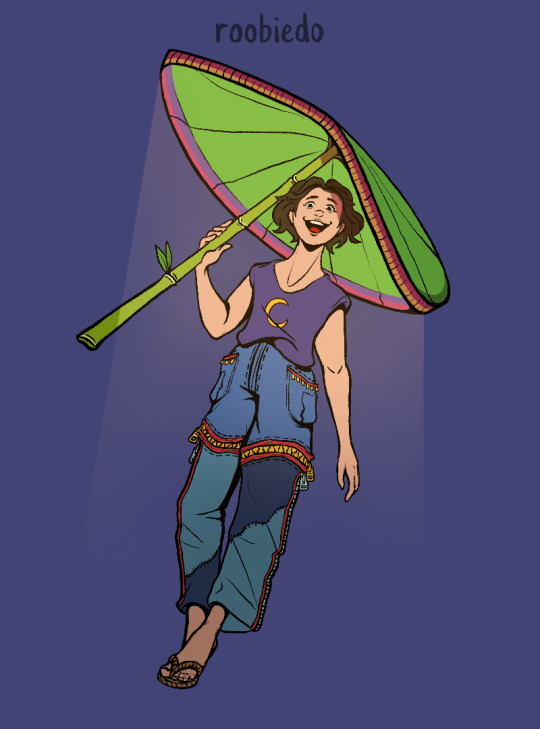
Disclaimer: I am not a science-y person, so I'm not sure how any of these would technically work or what materials would go into making them. Hopefully one day someone could figure it out, but I'm just having fun sharing these ideas for now :)
-----
What works well both in harsh sunlight and heavy downpours, plus is already something that people here use everyday? Umbrellas! How cool would it be to have an umbrella that absorbs sunlight during the day, and turns it into a personal spotlight at night? Or perhaps it could absorb and store large amounts of rainwater, to be re-used later or released somewhere more useful?
My main inspiration for this is the bamboo. This plant already plays a huge role in our lives here -- culturally, economically, and from what I recently learned, ecologically too! Our region suffers from floods often, and bamboo can help to control the flow of water, for example through their roots providing a barrier against soil erosion, or their ability to store large amounts of water and release it gradually during drier seasons. (And that's just one of the many reasons why bamboos are awesome and solarpunky!) I thought it would be cool to have water stored in the 'bamboo nodes' of the umbrella shaft, which could then be detached and used individually, or as components in other tech!
I chose the Amazonian lily pad as the canopy design because 1) it looks big enough to cover a person, 2) it has a wide surface for solar panels to 'photosynthesize' energy, 3) its container-like shape looks as though it could hold rainwater like a funnel while it trickles into the shaft, and 4) it just looks really pretty! Realistically, this canopy might not be able to do everything at once, so I'm hoping for this tech to be modular and highly customizable -- as in, you could replace this 'lily pad' with something else that serves a different function! I did play around with some other designs, here they are hehe
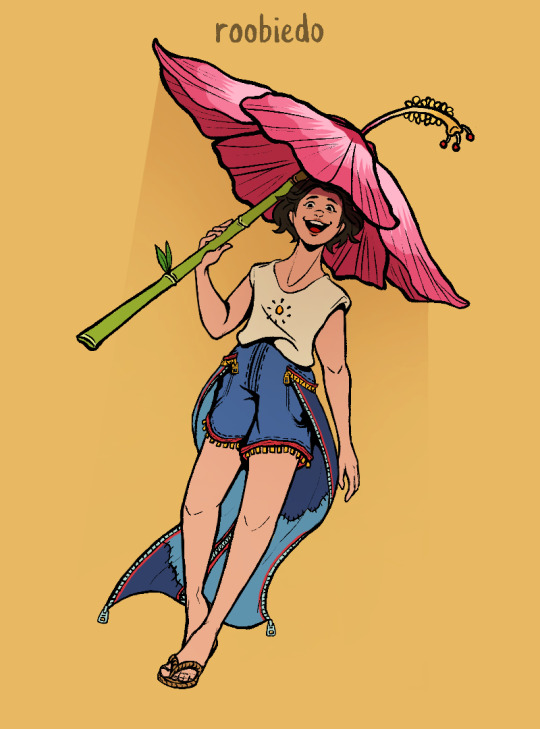
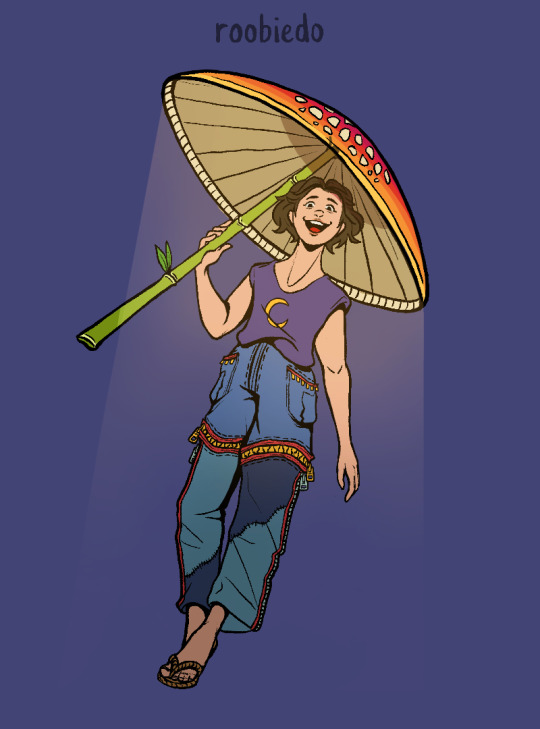
Hibiscus: Our national flower! Have these bad boys growing in my yard so I thought why not. Not sure what functions it would have yet... perhaps the pistil could be a sensor for gathering weather data? Or maybe the anthers are little lights? Maybe it attracts BEES???
Mushroom: Not familiar with the fungi in my area yet so I went with the classic Amanita. Though now I'm kinda regretting because! Wouldn't it be so cool and lunarpunky to design it based on a bio-luminescent mushroom, so it would make sense for the umbrella to glow in the dark? AGH missed opportunities ;;
-----
Anyway while I was designing the umbrella I thought about giving the model a cool fit too, so tadaaa! A customizable pair of pants that can be worn as a shorts + half-skirt/sarong combo during hot weather, or extended to become a full pair of jeans during colder/rainy times! I used zippers as the connectors because they seem easy to sew on and I like the punky vibe it adds to the outfit. HOWEVER, I'm realising that might be inconvenient or way too time consuming for some people. Maybe buttons, magnets or hook-and-loop fasteners would be easier?
As for the shirt, idk that was just for fun. Maybe it changes colour/design based on the surrounding temperature?
-----
So YEAH that was my longer-than-expected idea dump for this week! Thank you for reading <3 If you have any thoughts or ways of expanding on these ideas please please please share them with me I'm just really excited to see what people think waaaaa!!! ok bye stay hydrated
#art#artists on tumblr#solarpunk#solarpunk aesthetic week#winter solstice#no im not late im not I M NOT#fashion#roobiedoodle#tl simmer#i did not intend for it to be her but she looks similar enough! should use my OCs as models more often actually
103 notes
·
View notes
Text
‘Everything is parched’: Amazon struggles with drought amid deforestation
By now, the rivers should be full. But large-scale cattle farming, the climate crisis and weather events like El Niño mean Brazil is near the point of no return

Cows, dust and smoke. That was what greeted me on my return home to Altamira, after several weeks on the road. An unusually fierce dry season has taken a horrific toll on the Amazonian landscape, swathes of which are already denuded by cattle ranches. Together, they threaten the integrity of the world’s biggest tropical forest.
I will get to the science behind that horrifying statement shortly. But first, let me describe what is happening on the ground, in and around my home in Altamira, in Pará state, northern Brazil.
Everything is parched. The vegetation crunches underfoot. Compared with the rainy season, the forest has visibly shrunk back several metres from the roadside. The more resilient trees are holding on, but at the fringes, the weaker palms have started to shrivel up and turn brown.
Several areas in my neighbourhood are charred black from recent burning. Criminal land-grabbers are taking advantage of the tinder-dry conditions. Each morning when I wake, the air tastes of smoke. A pall blurs the horizon. Solar panels are unable to function as normal because the sunlight cannot pierce the haze.
Continue reading.
#brazil#brazilian politics#politics#environmentalism#environmental justice#amazon rainforest#mod nise da silveira#image description in alt
69 notes
·
View notes